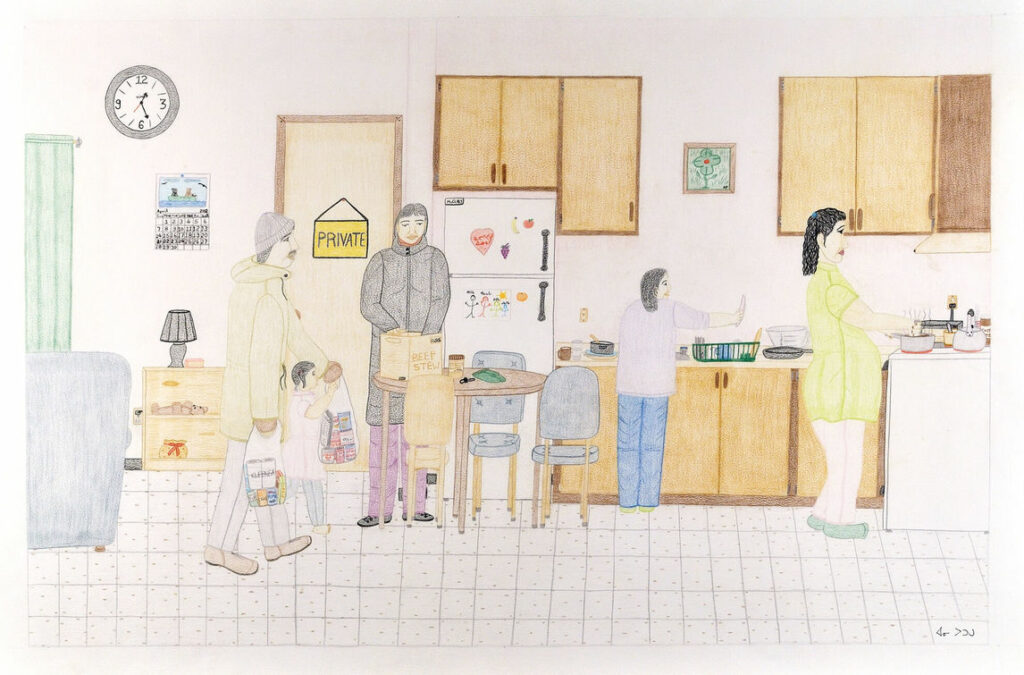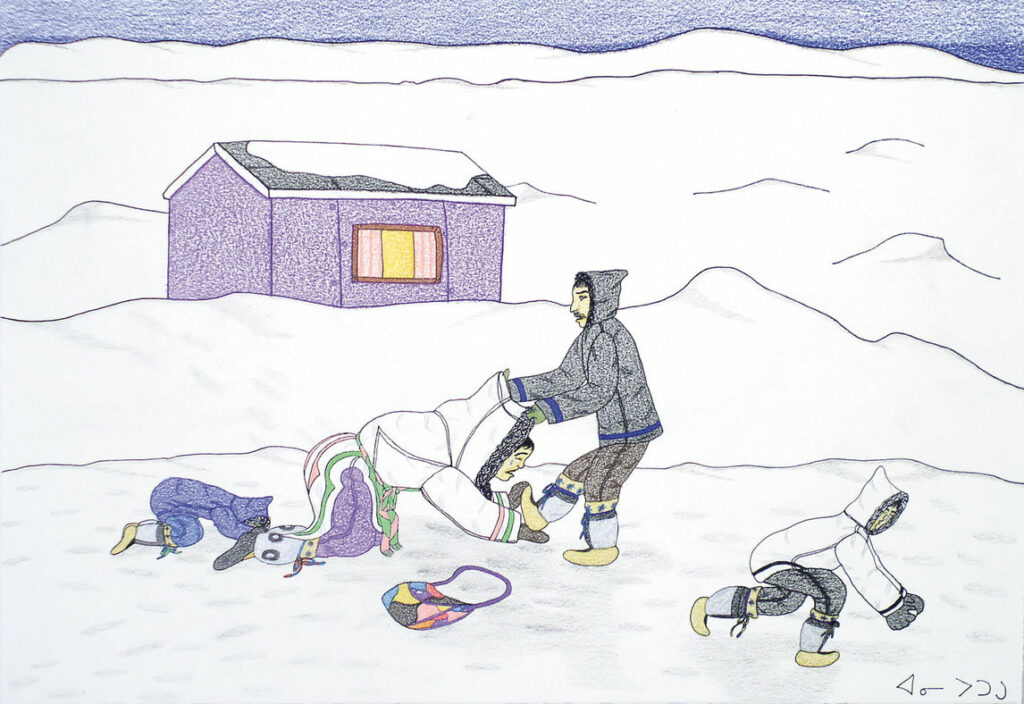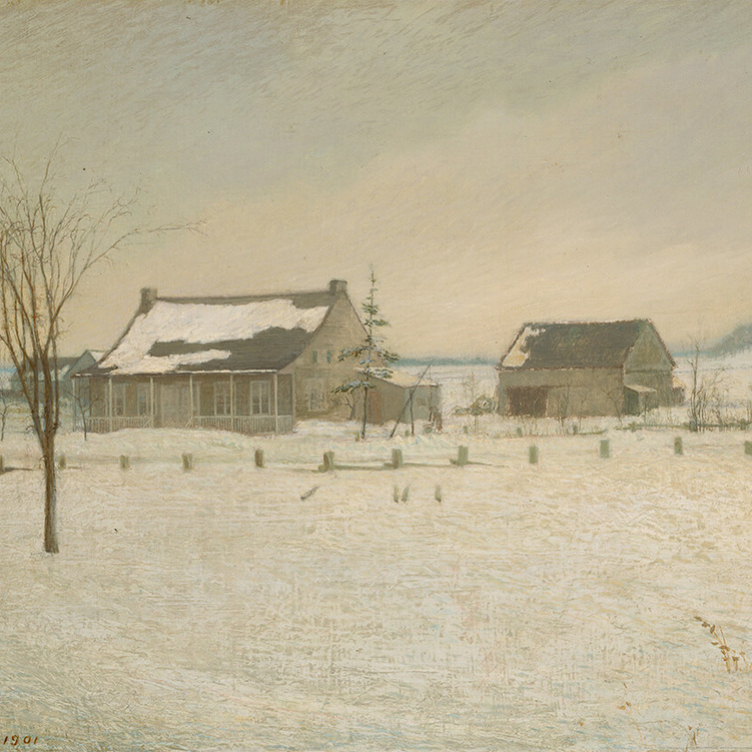The late Kinngait (Cape Dorset) artist Annie Pootoogook (1969–2016) is celebrated for her drawings of contemporary everyday life in her community. Early in her career, she was supported by fellow artists at the West Baffin Eskimo Co-operative (whose artistic division is now known as Kinngait Studios), but they also warned that her drawings might never sell. Her experimentation with subject matter expanded upon the work of her mother, Napachie Pootoogook (1938–2002), whose art was similarly wide ranging and included several works that confronted difficult social issues. For the younger Pootoogook, it was a gamble to depict contemporary subject matter based on her own experiences and to make works that might not sell and provide the income she needed. Inuit art historian Heather Igloliorte writes of the predicament facing Inuit artists: “While all around them their culture was being debased, devalued, and actively oppressed by the dual forces of colonialism and Christianity, these same values were revered, celebrated, and voraciously collected in their arts.” Pootoogook leapt past this predicament when she created a body of work that curators recognized as unusually contemporary, and collectors and museums bought her drawings eagerly.
Pootoogook holds a unique place in the history of Inuit art and within Canadian art history. Her work represents a fresh perspective on and distinct vision within her community. By the time she came of age, the community of Kinngait and the lives of its people were rapidly being transformed through the availability of Southern consumer goods and the penetration of mass communications. Pootoogook observed the circumstances of her modern life and surroundings objectively, without nostalgia and with no false romanticism. “I didn’t see any igloos in my life,” she said in a 2006 documentary. “Only Ski-Doo, Honda, the house, things inside the house.” She documented these things in her drawings just as honestly as her predecessors had documented their own lived experiences in earlier and far different times. Composition (Family Cooking in Kitchen), 2002, exemplifies her interest in “things inside the house.”

Wax pastel and graphite on Somerset paper, 76.4 x 111.6 cm, Art Gallery of Nova Scotia, Halifax.
Many Kinngait artists had already pushed at the boundaries of expectations regarding what should or could be consumed by the Southern art market, which was still accustomed to picturesque “ethnic” pieces supposedly emerging from a world of shamans and myths. Pootoogook’s mother, Napachie, is one such artist. Her later works, such as Untitled (Alcohol), 1993–94, or Trading Women for Supplies, 1997–98, included dark personal recollections and troubling scenes from her community. Yet at the time Pootoogook’s drawings were first shown in the South, Inuit art was still being compartmentalized by historians of Canadian art. The prevailing expectation was that what is Inuit is not contemporary.
It is worth considering the meaning of “contemporary”—a word that is both a simple description and a standard used to exclude certain artists and groups. It has been used for, among other things, art made in the past twenty years, with an awareness of current trends in art history; critical social consciousness in art; and experimentation for its own sake as a value in the arts. Informed by Eurocentric values, this definition often excludes culturally marginalized and remote populations.

Ink on paper, 50.8 x 66 cm, Collection of Edward J. Guarino.
An honest look at daily life in the Arctic in the twenty-first century through the eyes of a self-aware and often irreverent artist like Pootoogook was a shock for audiences in the South. A select group of dealers and curators were willing to accept that what they were seeing in Pootoogook’s works was important and maybe even unprecedented. Pootoogook came to the attention of the public quietly in a 2001 group exhibition titled The Unexpected at Feheley Fine Arts, a commercial gallery in Toronto. This culminated in a major solo exhibition in 2006 at The Power Plant Contemporary Art Gallery in Toronto—the first for an Inuit artist. For most artists, the road to reach a broader public takes years to travel. But through the determination and support of these dealers and curators, Pootoogook’s drawings quickly became celebrated for capturing the spirit of a time when Canada was looking at Indigenous cultures in new ways, not only in the arts, but also culturally, politically, and ethically.
This Essay is excerpted from Annie Pootoogook: Life & Work by Nancy G. Campbell.
 Karen Tam’s Autumn Tigers
Bridging Past and Present: Invisible Made Visible
By Imogene L. Lim, PhD
Karen Tam’s Autumn Tigers
Bridging Past and Present: Invisible Made Visible
By Imogene L. Lim, PhD
 The Frontier Portraits of C.D. Hoy
A Chinese Canadian Photographer’s Tribute to His Community
By Faith Moosang
The Frontier Portraits of C.D. Hoy
A Chinese Canadian Photographer’s Tribute to His Community
By Faith Moosang
 Interrogating Identity
Suzy Lake explores the role of photography in shaping how we understand and see ourselves
By Erin Silver
Interrogating Identity
Suzy Lake explores the role of photography in shaping how we understand and see ourselves
By Erin Silver
 An Emboldened Artist
How Oviloo Tunnillie achieved rare international acclaim as an Inuit female sculptor
By Darlene Coward Wight
An Emboldened Artist
How Oviloo Tunnillie achieved rare international acclaim as an Inuit female sculptor
By Darlene Coward Wight
 Painting the Cultural Mosaic
William Kurelek traversed the country in a quest to capture its diverse inhabitants
By Andrew Kear
Painting the Cultural Mosaic
William Kurelek traversed the country in a quest to capture its diverse inhabitants
By Andrew Kear
 Domestic Discontent
Mary Pratt’s poetic scenes of home life are praised for their political edge
By Ray Cronin
Domestic Discontent
Mary Pratt’s poetic scenes of home life are praised for their political edge
By Ray Cronin
 Meetings of Minds
Sorel Etrog found new ideas in collaborative work
By Alma Mikulinsky
Meetings of Minds
Sorel Etrog found new ideas in collaborative work
By Alma Mikulinsky
 Introducing Miss Chief
An excerpt from the ACI’s book “Revision and Resistance”
By Shirley Madill
Introducing Miss Chief
An excerpt from the ACI’s book “Revision and Resistance”
By Shirley Madill
 A Practice of Recovery
An excerpt from the ACI’s book “Revision and Resistance”
By Sasha Suda
A Practice of Recovery
An excerpt from the ACI’s book “Revision and Resistance”
By Sasha Suda
 Decolonizing History Painting
An excerpt from the ACI’s book “Revision and Resistance”
By Ruth B. Phillips and Mark Salber Phillips
Decolonizing History Painting
An excerpt from the ACI’s book “Revision and Resistance”
By Ruth B. Phillips and Mark Salber Phillips
 A Vision for the Future
An excerpt from the ACI’s book “Revision and Resistance”
By Nick Estes
A Vision for the Future
An excerpt from the ACI’s book “Revision and Resistance”
By Nick Estes
 Inside Kent Monkman’s Studio
An excerpt from the ACI’s book “Revision and Resistance”
By Jami C. Powell
Inside Kent Monkman’s Studio
An excerpt from the ACI’s book “Revision and Resistance”
By Jami C. Powell
 The Rule of Chance
Jean Paul Riopelle’s break with Automatism
By François-Marc Gagnon
The Rule of Chance
Jean Paul Riopelle’s break with Automatism
By François-Marc Gagnon
 From Taos to New York
Agnes Martin and the currents of American Art
By Christopher Régimbal
From Taos to New York
Agnes Martin and the currents of American Art
By Christopher Régimbal
 An Artist Blooms
Mary Hiester Reid’s floral aesthetics
By Andrea Terry
An Artist Blooms
Mary Hiester Reid’s floral aesthetics
By Andrea Terry
 The Patriotic Painter
Greg Curnoe’s Canada
By Judith Rodger
The Patriotic Painter
Greg Curnoe’s Canada
By Judith Rodger
 Walking, Stacking, Dancing
Françoise Sullivan’s conceptual 1970s
By Annie Gérin
Walking, Stacking, Dancing
Françoise Sullivan’s conceptual 1970s
By Annie Gérin
 The Extraordinary North
Tom Thomson’s diary of landscape
By David P. Silcox
The Extraordinary North
Tom Thomson’s diary of landscape
By David P. Silcox
 A Champion of Abstraction
Jock Macdonald sought a new expression in art
By Joyce Zemans
A Champion of Abstraction
Jock Macdonald sought a new expression in art
By Joyce Zemans
 Defiant Spirit
Quebecois artist Ozias Leduc drew on Europe but created a Canadian ideal
By Laurier Lacroix
Defiant Spirit
Quebecois artist Ozias Leduc drew on Europe but created a Canadian ideal
By Laurier Lacroix